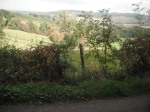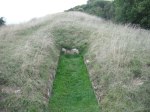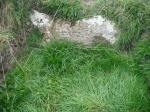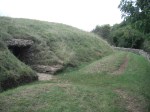On the 2nd of October 2014 I visited Belas Knap long barrow near Cheltenham (OS 163 OL45:SP021254). My English Heritage field guide had some information about it:
“A particularly fine example of a Neolithic long barrow of c.3800 BC, featuring a false entrance and side chambers. Excavated in 1863 and 1865, the remains of 31 people were found in the chambers. The barrow has since been restored. At Belas Knap the impressive entrance is a dummy and the burial chambers are entered from the sides of the barrow – when closed and covered by earth they would have been invisible from the outside.
It was probably constructed around 3000 BC and was used for successive burials over a period of years until eventually the burial chambers were deliberately blocked.
Opinion differs as to the reason for the false portal. It may have been to deter robbers, although little in the way of value has been found in undisturbed tomb chambers. Alternatively, it could be that the false entrance functioned as a ‘spirit door’, intended to allow the dead to come and go and partake of offerings brought to the tomb by their descendants.”
– excerpts from Heritage Unlocked – Guide to Free Sites in Bristol, Gloucestershire and Wiltshire, published by English Heritage.
There is more information, and aerial photographs, here.
Going to Belas Knap was different to my other field trips, in that I went in a car. The OS map was not in the library, and public transport had looked a bit tricky for this one, so when my sister suggested visiting a site together, I suggested this one. Though I didn’t have the challenges of the previous field trips (I didn’t have to work out my routes, take water, or weigh up food portions or books against bag weight.), part of me missed the opportunity to build up such anticipation of the site as before, or experience the unfolding landscape in the same way. But in place of this, I had that special feeling of sharing the trip, and the discovery.
Before setting off, we looked at the image in my field guide showing the diagram of Belas Knap, which showed the intriguing ‘false portal’, and the flat circle of stones buried in the heart of the barrow. This, and the chambers being on all 4 sides of this barrow, make is different to those I have already visited, and I wanted to experience that difference. Unlike the others, you cannot crawl into the depths of this barrow – Belas Knap keeps its interior secrets.
It is an uphill walk from the road to the barrow, and we passed a couple of other people along the way. The open landscape gave way to a kind of grotto-like tunnel of trees, and despite the barbed wire fence things began to feel a bit more ancient. The barrow appeared from behind a dry stone wall, seeming to hug the ground, and fit closely into the lay of the land. We ate some food near the false portal, and a big bee crawled onto me. Its that time of year when they get all slow, disorientated, and grounded. I used a stick to carefully place it on the dry stone wall.
This site feels like a hidden and secluded place, it does not have the hill top wind swept prominance of Uley and Stoney Littleton. This gives Belas Knap an intimate, cosy feel, especially on a warm day. Sitting in the lush grass I felt snug and sheltered. (A thought came into my mind – this would be a beautiful place to come if the world was ending). Still, standing on top of the barrow gives a wide sweep of a perspective across half of the landscape.
I couldn’t help wondering about the false portal – it has been speculated as being a dummy or deterrent – did the people who built this need to conceal and protect their ancestry from others? or was it considered a passageway for their spirits? Feeling of all these unknowns, lead me to press my mouth close against the false portal, and whisper my breath across its surface. I visited the chambers one by one, moving anti-clockwise from facing the false portal (I made a diagram-drawing of the barrow which labels these chambers).
So walking around to the left I entered the north west (NW) chamber. It is large and has stones big enough to sit on, with gravel on the ground. I sounded out some downward sliding pitches, and then found that when I cleared my throat the staccato reflected back nicely from the stone around me. I kept making short cough / throat clearing sounds, and decided to particularly work with finding rhythms at this barrow.
Moving to the south (S) chamber at the opposite end of the barrow to the false portal, I saw this is now sealed with a stone. The person-sized grassy pathway was so inviting I lay there face down – it seemed the most natural thing to do. I wanted to mirror something of what I had done at the false portal, so I opened and closed my mouth making low sounds directly into the grass and earth. A rhythm emerged from my jaw movement, and I had to breathe through the grass to sustain the sound, inhaling its healthy scent. After I got up, there was a small patch of flattened wet grass where my mouth had been.
Continuing around the barrow, the south east (SE) chamber had a very low entrance. I had a torch with me for the first time on a field trip – the benefit of not having to worry about a heavy bag! But I found I didn’t need it – after shining a light in I could see it was quite small and I decided I would rather just crawl in into the darkness. The stones inside made a hollow sound when tapped, and I found 4 of them with different pitches. I tapped out a sequence, cycled it, and hummed the pitches as they sounded.
The north east (NE) chamber was large like the NW one, and has 6 stones in a kind of ring. I could walk a small circuit around them, but hit myself against one that stuck out. I used this as a way to make a semi-regular sound – walking the circuit round and round, and making a single sound every time I hit that stone. A heavy-sounding bee flew into the chamber with me for a while, and I pitched myself to its heavy buzz.
Returning to join my sister and her dog near the false portal, I saw the bee I had put on the wall was exactly in the same spot, just slightly moving its legs. I watched it for some time.
- Sloe berries growing next to Belas knap long barrow
- False portal
- False portal
- NW chamber inside
- S chamber
- Stone on the S chamber
- SE chamber
- SE chamber with torchlight
- NE chamber outside
- NE chamber inside
- The bee, on the dry stone wall
- View from the top of the barrow
We left Belas Knap, passing more people on the way back, and decided to visit nearby Hailes Abbey (you can be more spontaneous with a car!). The ruins cover a large area, and wandering amongst them we tried out the audio guide, a hand held device which described the daily lives of the monks. It was easy to use and I liked the effect of hearing voices and the sound of spaces, it helped me rebuild the Abbey in my imagination. Hailes Abbey felt like a much more established ‘day out’ site than any of the others I have visited – it had a museum, shop and sold tea and coffee.
There is more information about Hailes Abbey here.
- Writing carved into walls
Drawings

Diagram of Belas Knap with sloe berry juice. I drew in the sloe bush and gate, the bee, my lunch box and my dictaphone
See more drawings of Belas Knap on the gallery page.
Audio
Note: these tracks are panned to use both left and right, so for the best experience use headphones or stereo speakers.
Both tracks are are composite arrangements (CA) of field recordings, or as I term them, ‘sound sketches’.
Track 1: (3.45 min) CA
For this composite audio, I imagined floating into the barrow through the false portal, passing through the earth and over the flat stone circle deep in its centre, and out through the south chamber. If this were possible, you would pass the NE chamber on your left and the NW chamber on your right, then shortly after you would pass the SE chamber on your left before meeting the S chamber direct ahead. So in this audio, I arranged the left-right panning and the entries of the recordings from each chamber in this way. This first audio overlays the recordings, creating parallel-running polyrhythms in free time.
Track 2: (1.11 min) CA
In this second audio, I took the S chamber recording as a basis or ‘ground-bass’, and aligned a spliced element from each of the other chambers, including the false portal, to form the closest thing to a clear ‘rhythmic’ piece so far in this project. But rather than a strict ‘metronome’ feeling, I wanted to keep the human quality of breathing, so I left in the gaps where intakes of breath are audible, and the track has a variable, slightly wonky-feeling pulse.

































